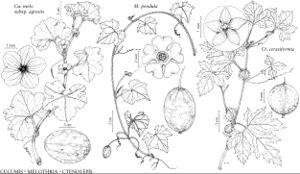Melothria
Sp. Pl. 1: 35. 1753.
Gen. Pl. ed. 5, 21. 1754.
| Taxon | Illustrator ⠉ | |
|---|---|---|
 | Cucumis sativus var. sativus Melothria pendula Ctenolepis cerasiformis | Yevonn Wilson-Ramsey Yevonn Wilson-Ramsey Yevonn Wilson-Ramsey |
Plants herbs, perennial [annual], monoecious, climbing, trailing, or creeping; stems annual, glabrous or hispid [pilose]; roots tuberous; tendrils unbranched. Leaves: blade ovate-reniform, cordate-pentangular, suborbiculate to depressed-ovate, ovate, ovate-triangular, or lanceolate-hastate, subentire or shallowly to deeply palmately 3–5-lobed or angled, lobes deltate to shallowly triangular, margins denticulate [dentate, shallowly sinuate, or subentire], surfaces eglandular. Inflorescences: staminate flowers 2–6 in axillary racemes or corymboid to subumbelloid clusters; pistillate flowers solitary, usually in same axils as staminate; bracts absent. Flowers: hypanthium campanulate; sepals 5, triangular to ovate, straight; petals 5, connate 1/2 length, yellow or orange-yellow [white or pale orange], oblong to ovate-oblong or obovate-oblong, 1.5–2 [–3.5] mm, glabrous or villosulous, corolla rotate to campanulate-rotate. Staminate flowers: stamens 3; filaments inserted near hypanthium base or near mid tube, distinct; thecae distinct, oblong, connective broadened; pistillodes present, nectariferous. Pistillate flowers: ovary 3-locular, globose to ovoid or fusiform; ovules ca. 15–20 per locule; style 1, short-columnar; stigmas 3, 2-lobed; staminodes 3 or absent. Fruits pepos, greenish, often striped or mottled, apparently usually maturing yellow to orange or purplish black, usually ellipsoid to ovoid, sometimes subglobose to globose, (0.8–) 1–2.5 cm, smooth, glabrous, indehiscent. Seeds 30–60, ovoid to ellipsoid, compressed, not arillate, margins not differentiated, surface smooth, white-sericeous. x = 12.
Distribution
United States, Mexico, West Indies, Central America, South America, in Asia
Discussion
Species 12 (1 in the flora).
The concept of Melothria was considerably narrowed by C. Jeffrey (1962), leaving the genus an entirely New World taxon characterized by long-peduncled fruits and staminate racemes, compressed seeds, and three stamens per flower, two of which are 2-thecous and the other 1-thecous. The segregated (or revived) genera Mukia Arnott (four species), Solena Loureiro (one species), and Zehneria Endlicher (30 species) are from the Old World tropics.
Selected References
None.